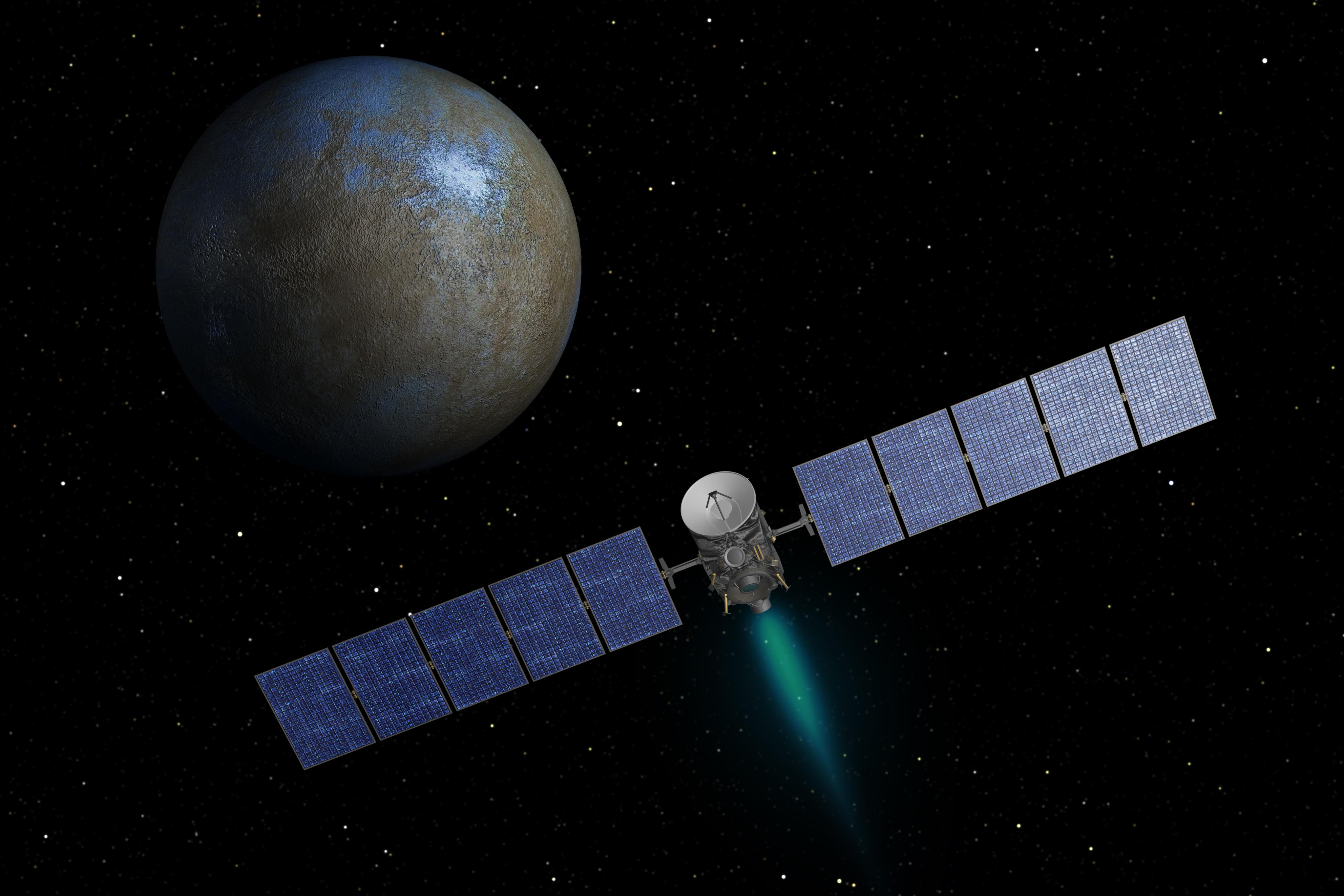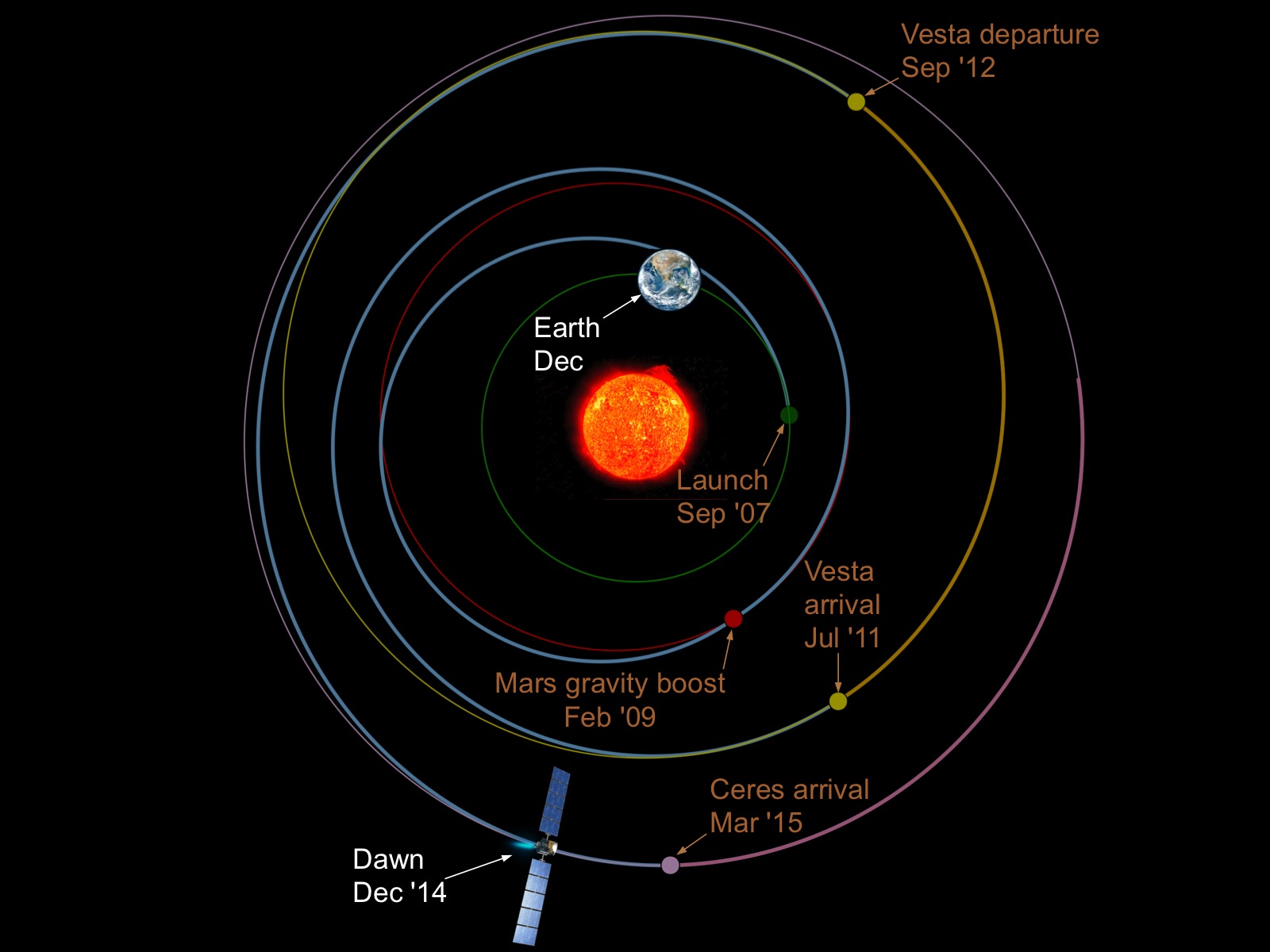
See below Dawn’s 1st resolved image of Ceres!
After a seven-year trek, and at the dawn of a new year, NASA’s revolutionary Dawn spacecraft has begun the final approach phase to dwarf planet Ceres for an unprecedented examination of this mysterious and never-before-visited world.
Coincidentally, Ceres was discovered on New Year’s Day, Jan. 1, 1801, by Giuseppe Piazzi of Italy.
Ceres is the largest and most massive object in the main Asteroid Belt, which lies between Mars and Jupiter. It measures about the size of Texas, with a diameter of approximately 590 miles (950 kilometers).
Scientists are keenly interested in Ceres as it may harbor an ocean of liquid water as large in volume as the oceans of Earth below a thick, icy mantle—despite its small size—and thus could be a potential abode for life.
But no one knows for sure, and unlocking the secrets to the most fundamental science questions of life and the Solar System’s formation is what Dawn’s objectives are all about.
And with the recent findings from ESA’s Rosetta mission that asteroids may have delivered more water to the early Earth than comets, Dawn’s arrival at watery Ceres couldn’t be more prescient.

As of today, Jan. 3, Dawn is about 382,000 miles (614,000 kilometers) from Ceres and closing in from the far side of the Sun at a velocity of around 450 miles per hour (725 kilometers per hour).
The current distance to Ceres equates to about 1.6 times the average distance between Earth and the Moon.
It’s going to be a remarkable year for space science and NASA’s Dawn Asteroid orbiter, which is an international collaborative project between NASA and several European countries, including Germany, Italy, and Holland.
The solar-powered Dawn will make space history on several fronts when it finally arrives in orbit around Ceres on March 6, 2015, for an up-close investigation.
It will be humanity’s first visitor to this utterly alien world, and Dawn will become humanity’s first spacecraft ever to visit and orbit two worlds in one mission—rather than just conduct multiple planetary flybys such as accomplished by NASA’s wildly successful twin Voyager probes launched back in the 1970s.
Dawn will achieve orbit by gravitational capture purely through the action of the ion thrusters. After arriving in March, it will gradually spiral in over about six weeks to an initial target science orbit of about 8,400 miles (13,500 kilometers) by April 23, 2015.
The Dawn mission’s unprecedented feat of surveying two worlds is only made possible by the revolutionary use of powering it by an exotic ion propulsion system which is vastly more efficient than chemical propulsion thrusters. Indeed, the ability to orbit two bodies in one mission is only enabled via the use of the ion engines propelled by xenon gas.

“Orbiting both Vesta and Ceres would be truly impossible with conventional propulsion. Thanks to ion propulsion, we’re about to make history as the first spaceship ever to orbit two unexplored alien worlds,” said Marc Rayman, Dawn’s chief engineer and mission director, based at NASA’s Jet Propulsion Laboratory in Pasadena, Calif.
In an ion propulsion engine, an electrical charge is applied to xenon gas, and charged metal grids accelerate the xenon particles out of the thruster. These particles push back on the thruster as they exit, creating a reaction force that propels the spacecraft, according to a NASA description.
So far, Dawn has accumulated five years of ion thrust time—far more than any other spacecraft, such as the predecessor Deep Space 1 spacecraft.
Dawn is part of NASA’s Discovery program and was launched on Sept. 27, 2007, by a United Launch Alliance (ULA) Delta II Heavy rocket from Space Launch Complex-17B (SLC-17B) at Cape Canaveral Air Force Station, Fla.

Dawn already made history when the probe achieved orbit around Vesta in July 2011 to become the first spacecraft from Earth to orbit a body in the main Asteroid Belt. The probe remained in orbit for an extended mission of 14 months, yielding reams of bonus science images and spectral data for the research teams until September 2012.
It has been thrusting using ion propulsion for much of the time since departing Vesta’s orbit over two years ago.
Vesta is the second most massive object in the Asteroid Belt. The odd-shaped world lacks a south pole and has an average diameter of 326 miles (525 kilometers).
In contrast to icy Ceres, Vesta is a rocky world. And Dawn’s science team aims to find out why they vary so greatly in composition, despite being rather close in celestial terms.
To date, the best views of Ceres have been captured by NASA’s iconic Hubble Space Telescope (HST) using the Advanced Camera for Surveys (ACS) instrument between December 2003 and January 2004.
The sharpness of Hubble’s Ceres image shown has been enhanced to bring out additional surface features, including brighter and darker regions that could be asteroid impact features. The observations were made in visible and ultraviolet light.
Since Ceres and Vesta are pristine proto planets, and also among the oldest bodies in our Solar System, scientists are eager to study them and search for clues about the formation, evolution, and early history of the Solar System.
Dawn is thus a mission to explore infant planets at the earliest epochs, amounting to a “Journey to the Beginning of Our Solar System” some 4.6 billion years ago.
Despite Hubble’s observation, we know very little about Ceres.
“It’s just a fuzzy blob,” says Rayman.
Unlike Vesta, which accounts for 5 percent of all known meteorites collected on Earth and provides a wealth of geologic and compositional data and insights, there are none we know of from Ceres.
“Ceres is almost a complete mystery to us,” said Christopher Russell, principal investigator for the Dawn mission, based at the University of California, Los Angeles.
“Ceres, unlike Vesta, has no meteorites linked to it to help reveal its secrets. All we can predict with confidence is that we will be surprised.”
Dawn is equipped with three science instruments to photograph and investigate the surface mineralogy and elemental composition of the asteroid. The instruments were provided by the U.S., Germany, and Italy.
The framing cameras supplied by Germany will be taking new images during the approach phase, and they should exceed the resolution of Hubble’s images by late January and reveal never-before-seen details.
The most recent framing camera image and first resolved image of Ceres was taken Dec. 1, 2014, and is shown here:

Since Ceres is also 3.77 AU (351 million miles, or 564 million kilometers) from Earth, radio signals traveling at the universal limit of the speed of light take about 30 minutes one way. So we’ll also have to wait just a little bit longer for those images to arrive.
Ceres is truly a world waiting to be unveiled for the first time in human history, and the riches are just weeks away thanks to Dawn and the entire science and engineering teams that have toiled away for more than a decade.
So stay tuned here for continuing updates!
Want to keep up-to-date with all things space? Be sure to “Like” AmericaSpace on Facebook and follow us on Twitter: @AmericaSpace





One Comment
One Ping
Pingback:Coming Down the Home Stretch: New Horizons Begins Historic Long-Range Reconnaissance of Pluto, Prior to Closest Approach in July « AmericaSpace